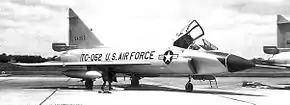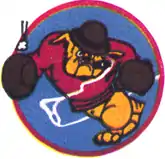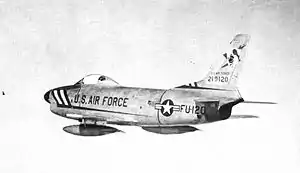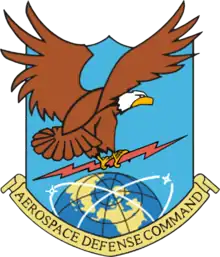86th Fighter-Interceptor Squadron
The 86th Fighter-Interceptor Squadron is an inactive United States Air Force unit. Its last assignment was with the 79th Fighter Group at Youngstown Air Force Base, Ohio, where it was inactivated on 1 March 1960.
| 86th Fighter-Interceptor Squadron | |
|---|---|
 Convair TF-102A Delta Dagger, AF Ser. No. 55-4052, of the 86th Fighter-Interceptor Squadron | |
| Active | 1942–1947 1952–1960 |
| Country | |
| Branch | |
| Type | Fighter-Interceptor |
| Role | Air Defense |
| Engagements | Mediterranean Theater of Operations |
| Decorations | Distinguished Unit Citation |
| Insignia | |
| Patch including the 86th Fighter-Interceptor Squadron Emblem |  |
| 86th Fighter Squadron emblem |  |
The squadron was first activated shortly after the United States entered World War II as the 86th Pursuit Squadron. As the 86th Fighter Squadron It saw combat in the Mediterranean Theater of Operations and earned two Distinguished Unit Citations. After the end of the war it became an element of the occupation forces until returning to the United States, where it was inactivated in 1947.
It was activated once again to replace an Air National Guard squadron that had been mobilized for the Korean War and carried out the air defense of the Great Lakes area for the next eight years.
History
World War II
The squadron was first activated in early 1942 at Dale Mabry Field, Florida[1] as the 86th Pursuit Squadron, one of the original three squadrons of the 79th Pursuit Group.[2] Its initial cadre was drawn from the 56th and 81st Fighter Groups.[3] The squadron was redesignated the 86th Fighter Squadron in May 1942. The unit trained in the United States, then moved to Egypt by sea via Brazil in October–November 1942,[3] where it became part of Ninth Air Force.[2]
The squadron trained with P-40 Warhawks while moving westward in the wake of the British drive across Egypt and Libya to Tunisia.[2] By escorting bombers, attacking enemy shipping, and supporting ground forces, the 86th took part in the Allied operations that defeated Axis forces in North Africa, captured Pantelleria, and conquered Sicily.[2] The squadron was awarded a Distinguished Unit Citation (DUC) for its support of British Eighth Army during that period, March–August 1943.[1]
The squadron became part of Twelfth Air Force in August 1943 and continued to support the British Eighth Army by attacking troop concentrations, gun positions, bridges, roads, and rail lines in southern Italy.[2] It operated in the area of the Anzio beachhead from January to March 1944. The unit participated in the drive on Rome from March to June 1944, and converted to P-47 Thunderbolts during that time. It flew escort and strafing missions in southern France during August and September 1944, and afterward returned to Italy and engaged in interdiction and close air support operations in northern Italy. The 86th received a second DUC for numerous missions flown at minimum altitude in intense flak to help pierce the enemy line at the Santerno River in Italy in April 1945.[2] Squadron pilots were credited with twenty-eight victories over enemy aircraft during World War II.[4]
The squadron remained overseas as part of United States Air Forces in Europe after the war as part of the occupation forces. It was transferred, without personnel and equipment, to the US in June 1947 and inactivated on 15 July 1947.[1]
Cold War Air Defense

The squadron was redesignated the 86th Fighter-Interceptor Squadron and activated in November 1952 at Youngstown Municipal Airport,[1] where it replaced the federalized 166th Fighter-Interceptor Squadron,[5] which was released to the Ohio Air National Guard. As an element of Air Defense Command (ADC) it was responsible for air defense of the Great Lakes area, initially with the Republic F-84 Thunderjets it inherited from the 166th.[6]
Three months later ADC reorganized it dispersed fighter bases and the 86th Fighter-Interceptor Squadron was assigned to the 502d Air Defense Group,[1] which assumed control of ADC operational and support elements at Youngstown.[7] In July the squadron upgraded to radar equipped and rocket armed North American F-86D Sabres at Youngstown.[6]
In August 1955 ADC implemented Project Arrow, which was designed to bring back on the active list the fighter units which had compiled memorable records in the two world wars.[8] At Youngstown, the squadron's World War II headquarters, the 79th Fighter Group assumed the personnel and equipment of the 502d Air Defense Group, which was simultaneously inactivated.[7]
In September 1957 the 86th traded its Sabres for AIM-4 Falcon armed Convair F-102 Delta Dagger aircraft equipped with data link for interception control through the Semi-Automatic Ground Environment system.[6] The Air Force transferred command of Youngstown MAP from ADC to Continental Air Command on 1 March 1960 and the 79th Fighter Group and its components inactivated that date.[9]
Lineage
- Constituted as the 86th Pursuit Squadron (Interceptor) on 13 January 1942
- Activated on 9 February 1942
- Redesignated 86th Fighter Squadron (Single Engine) on 15 May 1942
- Inactivated on 15 July 1947
- Redesignated 86th Fighter-Interceptor Squadron on 11 September 1952
- Activated on 1 November 1952
- Inactivated on 1 March 1960[10]
Assignments
- 79th Pursuit Group (later Fighter Group), 9 February 1942 – 15 July 1947
- 4708th Defense Wing, 1 November 1952
- 502d Air Defense Group, 16 February 1953
- 79th Fighter Group, 18 August 1955 – 1 March 1960[10]
Stations
|
|
Aircraft
|
|
Awards and campaigns
| Award streamer | Award | Dates | Notes |
|---|---|---|---|
| Distinguished Unit Citation | March 1943 – 17 August 1943 | 86th Fighter Squadron, North Africa and Sicily[1] | |
| Distinguished Unit Citation | 16 April 1945 – 20 April 1945 | 86th Fighter Squadron, Italy[1] |
| Campaign Streamer | Campaign | Dates | Notes |
|---|---|---|---|
| Air Combat, EAME Theater | 86th Fighter Squadron[1] | ||
| Egypt-Libya | 86th Fighter Squadron[1] | ||
| Tunisia | 86th Fighter Squadron[1] | ||
| Sicily | 86th Fighter Squadron[1] | ||
| Naples-Foggia | 86th Fighter Squadron[1] | ||
| Anzio | 86th Fighter Squadron[1] | ||
| Rome-Arno | 86th Fighter Squadron[1] | ||
| Southern France | 86th Fighter Squadron[1] | ||
| Northern Apennines | 86th Fighter Squadron[1] | ||
| Po Valley | 86th Fighter Squadron[1] | ||
| World War II Army of Occupation | 2 May 1945 – 25 June 1947 | 86th Fighter Squadron[1] |
References
- Notes
- The squadron was located at Alexandria by 1 January 1943. "Abstract, History of 79th Ftr Gp CY 1943". Air Force History Index. Retrieved 13 May 2012.
- The 79th group moved to Corsica by ship.
- The group history identifies this field as "Bron Airdrome".
- Citations
- Maurer, Combat Squadrons, pp. 297–298
- Maurer, Combat Units, pp. 144–145
- Abstract, History of 79 Fighter Group, activation-Aug 43. Retrieved 13 May 2012
- Newton & Senning, p. 578
- Cornett & Johnson, p. 123
- Cornett & Johnson, p. 120
- Cornett & Johnson. p. 81
- Buss, et al., p.6
- Abstract, History of 79th Ftr Gp, Jan–Mar 1960. Retrieved 13 May 2012
- Lineage, assignments and aircraft in Maurer, Combat Squadrons, pp. 278–279
- Watkins, pp. 30–31
- Abstract,, History of 79th Ftr Gp, Jun 1944. Retrieved 13 May 2012
- Airfield Identification Numbers from Johnson.
- Abstract,, History of 79th Ftr Gp, Sep 1944. Retrieved 13 May 2012
- Except as noted, stations in Maurer, Combat Squadrons, pp. 278–279
Bibliography
![]() This article incorporates public domain material from the Air Force Historical Research Agency website http://www.afhra.af.mil/.
This article incorporates public domain material from the Air Force Historical Research Agency website http://www.afhra.af.mil/.
- Buss, Lydus H.(ed), Sturm, Thomas A., Volan, Denys, and McMullen, Richard F., History of Continental Air Defense Command and Air Defense Command July to December 1955, Directorate of Historical Services, Air Defense Command, Ent AFB, CO, 1956
- Cornett, Lloyd H; Johnson, Mildred W (1980). A Handbook of Aerospace Defense Organization, 1946–1980 (PDF). Peterson AFB, CO: Office of History, Aerospace Defense Center.
- Johnson, 1st Lt. David C. (1988). U.S. Army Air Forces Continental Airfields (ETO) D-Day to V-E Day (PDF). Maxwell AFB, AL: Research Division, USAF Historical Research Center. Archived from the original (PDF) on 29 September 2015. Retrieved 26 June 2017.
- Maurer, Maurer, ed. (1983) [1961]. Air Force Combat Units of World War II (PDF) (reprint ed.). Washington, DC: Office of Air Force History. ISBN 0-912799-02-1. LCCN 61060979.
- Maurer, Maurer, ed. (1982) [1969]. Combat Squadrons of the Air Force, World War II (PDF) (reprint ed.). Washington, DC: Office of Air Force History. ISBN 0-405-12194-6. LCCN 70605402. OCLC 72556.
- Newton, Wesely P., Jr.; Senning, Calvin F. (1963). "USAF Credits for the Destruction of Enemy Aircraft, World War II, USAF Historical Study No. 85" (PDF). Research Studies Institute, USAF Historical Division, Air University. Retrieved 26 June 2017.
- Watkins, Robert A. (2009). Insignia and Aircraft Markings of the U.S. Army Air Force in World War II. Volume IV, European-African-Middle Eastern Theater of Operations. Atglen, PA: Shiffer Publishing, Ltd. pp. 30–31. ISBN 978-0-7643-3401-6.
Further reading
- Coles, Harry C. (February 1945). "Ninth Air Force in the Western Desert Campaign to 23 January 1943, USAF Historical Study No. 30" (PDF). Assistant Chief of Air Staff Intelligence, Historical Division. Retrieved 26 June 2017.
- Coles, Harry C. (November 1945). "Participation by the Ninth and Twelfth Air Forces in the Sicilian Campaign, USAF Historical Study No. 37" (PDF). AAF Historical office. Retrieved 26 June 2017.
- Grant, C. L. "The Development of Continental Air Defense to 1 September 1954, USAF Historical Study No. 126" (PDF). Research Studies Institute, USAF Historical Division, Air University. Retrieved 26 June 2017.
- Leonard, Barry (2009). History of Strategic Air and Ballistic Missile Defense (PDF). Vol I. 1945–1955. Fort McNair, DC: Center for Military History. ISBN 978-1-4379-2131-1.
- Leonard, Barry (2009). History of Strategic Air and Ballistic Missile Defense (PDF). Vol II, 1955–1972. Fort McNair, DC: Center for Military History. ISBN 978-1-43792-131-1.
- Woerpel, Don. The 79th Fighter Group: Over Tunisia, Sicily, and Italy in World War II. Atglen, Pennsylvania: Schiffer Publishing, 2007. ISBN 0-7643-1322-3.
- "ADCOM's Fighter Interceptor Squadrons". The Interceptor. Aerospace Defense Command. 21 (1): 5–11, 26–31, 40–45, 54–59. January 1979.

.svg.png.webp)